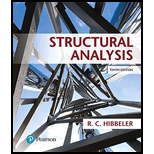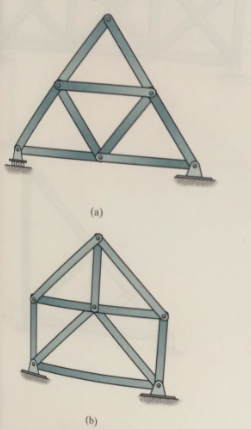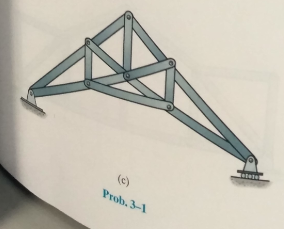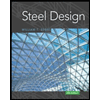
Classify each of the following trusses as statically determinate, statically indeterminate, or unstable. If indeterminate, state its degree.


(a)
If, the truss is statically determinate, statically indeterminate or unstable and its degree.
Answer to Problem 3.1P
The truss is statically determinate.
Explanation of Solution
Given:
One end of the truss has roller support and the other end has pinned support.
Concept Used:
The determinacy of the structure is obtained from the formula:
If
If
If
Where j is the number of joints.
m is the number of members of the truss.
r is the number of reactions at the support.
In case of pinned support there are two reactions.
In case of roller support there is only one reaction.
In case of fixed support there are three reactions.
In case of simple support there is only one reaction.
Calculation:
Here,
Which implies that the truss is statically determinate.
Conclusion:
Hence, the truss is statically determinate.
(b)
If, the truss is statically determinate, statically indeterminate or unstable and its degree if indeterminate.
Answer to Problem 3.1P
The truss is statically indeterminate.
Degree of indeterminacy i=2.
Explanation of Solution
Given:
Both the ends of the truss have pinned joint.
Concept Used:
The determinacy of the structure is obtained from the formula:
If
If
If
Where j is the number of joints.
m is the number of members of the truss.
r is the number of reactions at the support.
In case of pinned support there are two reactions.
In case of roller support there is only one reaction.
In case of fixed support there are three reactions.
In case of simple support there is only one reaction.
Calculation:
Here,
Which implies that the truss is statically indeterminate with degree of indeterminacy as 2.
Conclusion:
Truss is statically indeterminate.
Degree of indeterminacy i=2.
(c)
If, the truss is statically determinate, statically indeterminate or unstable. If statically indeterminate and its degree.
Answer to Problem 3.1P
The truss is statically determinate.
Explanation of Solution
Given:
One end of the truss has pinned support and the other end has roller support.
Concept Used:
The determinacy of the structure is obtained from the formula:
If
If
If
Where j is the number of joints
m is the number of members of the truss
r is the number of reactions at the support
In case of pinned support there are two reactions
In case of roller support there is only one reaction
In case of fixed support there are three reactions
In case of simple support there is only one reaction
Calculation:
Here,
Which implies that the truss is statically determinate.
Conclusion:
Truss is statically determinate.
Want to see more full solutions like this?
Chapter 3 Solutions
Structural Analysis (10th Edition)
Additional Engineering Textbook Solutions
Starting Out with C++: Early Objects (9th Edition)
Starting Out with Java: From Control Structures through Data Structures (4th Edition) (What's New in Computer Science)
Computer Science: An Overview (13th Edition) (What's New in Computer Science)
Database Concepts (8th Edition)
SURVEY OF OPERATING SYSTEMS
Introduction To Programming Using Visual Basic (11th Edition)
- Calculate the BMs (bending moments) at all the joints of the beam shown in Fig.1 using the slope deflection method, draw the resulting shear force diagran and bending moment diagram. The beam is subjected to an UDL of w=65m. L=4.5m, L1= 1.8m. Assume the support at C is pinned, and A and B are roller supports. E = 200 GPa, I = 250x106 mm4.arrow_forwardProblem 2 (A is fixed and C is a pin) Find the reactions and A and C. 10 k- 6 ft 6 ft B A 2 k/ft 15 ftarrow_forward6. A lake with no outlet is fed by a river with a constant flow of 1200 ft3/s. Water evaporates from the surface at a constant rate of 13 ft3/s per square mile of surface area. The surface area varies with the depth h (in feet) as A (square miles) = 4.5 + 5.5h. What is the equilibrium depth of the lake? Below what river discharge (volume flow rate) will the lake dry up?arrow_forward
- Problem 5 (A, B, C and D are fixed). Find the reactions at A and D 8 k B 15 ft A -20 ft C 10 ft Darrow_forwardProblem 4 (A, B, E, D and F are all pin connected and C is fixed) Find the reactions at A, D and F 8 m B 6m E 12 kN D F 4 marrow_forwardProblem 1 (A, C and D are pins) Find the reactions and A, C and D. D 6 m B 12 kN/m 8 m A C 6 marrow_forward
- Uniform Grade of Pipe Station of Point A is 9+50.00. Elevation Point A = 250.75.Station of Point B is 13+75.00. Elevation Point B = 244.10 1) Calculate flowline of pipe elevations at every 50 ft. interval (Half Station). 2) Tabulate station and elevation for each station like shown on example 3) Draw Sketcharrow_forward40m 150N B 40marrow_forwardquantity surveyingarrow_forward
- Quantity Surveyingarrow_forwardquantity surveyingarrow_forwardNote: Please accurately answer it!. I'll give it a thumbs up or down based on the answer quality and precision. Question: What is the group name of Sample B in problem 3 from the image?. By also using the ASTM flow chart!. This unit is soil mechanics btwarrow_forward

 Steel Design (Activate Learning with these NEW ti...Civil EngineeringISBN:9781337094740Author:Segui, William T.Publisher:Cengage Learning
Steel Design (Activate Learning with these NEW ti...Civil EngineeringISBN:9781337094740Author:Segui, William T.Publisher:Cengage Learning Materials Science And Engineering PropertiesCivil EngineeringISBN:9781111988609Author:Charles GilmorePublisher:Cengage Learning
Materials Science And Engineering PropertiesCivil EngineeringISBN:9781111988609Author:Charles GilmorePublisher:Cengage Learning Engineering Fundamentals: An Introduction to Engi...Civil EngineeringISBN:9781305084766Author:Saeed MoaveniPublisher:Cengage Learning
Engineering Fundamentals: An Introduction to Engi...Civil EngineeringISBN:9781305084766Author:Saeed MoaveniPublisher:Cengage Learning Principles of Foundation Engineering (MindTap Cou...Civil EngineeringISBN:9781305081550Author:Braja M. DasPublisher:Cengage Learning
Principles of Foundation Engineering (MindTap Cou...Civil EngineeringISBN:9781305081550Author:Braja M. DasPublisher:Cengage Learning Principles of Foundation Engineering (MindTap Cou...Civil EngineeringISBN:9781337705028Author:Braja M. Das, Nagaratnam SivakuganPublisher:Cengage Learning
Principles of Foundation Engineering (MindTap Cou...Civil EngineeringISBN:9781337705028Author:Braja M. Das, Nagaratnam SivakuganPublisher:Cengage Learning





